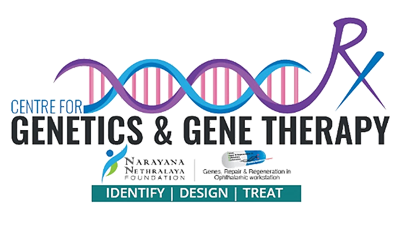Ocular Genetics
-
Narayana Netralaya Foundation > Ocular Genetics
Ocular Genetics- Cornea
Keratoconus (KC) is a multi-factorial disease with the involvement of genetic and environmental factors. Several GWAS studies discussed the involvement of genes and its association of KC and other ocular discomforts. We aim to explore the genetic heterogeneity and gene variant identification by high-throughput sequencing in South Asian population. We have our in-house NGS data analysis pipeline and variant prioritization scoring algorithm to find the potent variants underlying in the pathogenesis of Keratoconus.
We recruited 9 families, which could possibly have genetic influence in the pathogenesis of KC progression. Blood samples were collected from 41 individuals (24 KC subjects and 17 healthy first-degree relatives) and whole exome sequencing (WES) was performed. WES revealed variations in the genes involved in regulation of inflammation, a major pathologic driver in KC patients. 485 variants in 57 genes were identified with diverse inheritance patterns. Within these, 28 variants were nonsynonymous with predicted deleterious effects. Further, the variants present in 2 or more families with allele frequency less than 1X10-5 were identified. Variations in novel genes involved in regulation of inflammatory signalling including ADAMTS18, ANKRD36B/C, CTBP2, FAM104B, KIR2DL1, etc were present in KC subjects. Network analysis revealed their interaction with 138 genes associated with major signalling pathways including inflammation, of which 131 genes showed differential expression in KC epithelium [Kannan et al, 2022].
Chronic inflammation in KC may be due to mutations in proteins that regulate inflammatory signalling pathways. Our data reveal novel genes including metalloproteinases with possible immunomodulatory roles which may be useful for genomic diagnostics as well as serve as therapeutic targets for KC. Together, our findings provide novel insights into plausible mechanisms underlying the pathogenesis of KC.
Ref: Kannan, Ramaraj, et al. "Novel genes and variants associated with inflammation identified in Keratoconus families." Investigative Ophthalmology & Visual Science 63.7 (2022): 507-A0084.
Ocular Genetics - Retina
Inherited retinal dystrophies (IRDs) are a group of ocular genetic disorders of the retina with a global prevalence of ~4.5 million. Their age of onset can range from presenting congenitally until even late adulthood. IRDs are characterized by degeneration of retinal pigment epithelium and the photoreceptors causing progressive loss of vision. IRDs are often misdiagnosed due to the genetic heterogeneity and overlapping clinical phenotypes. The mechanism underlying the loss of photoreceptors is poorly understood. Currently there is gene therapy available only for IRD caused by mutation in the gene RPE65. The genetic database available consists of gene mutations commonly found in the European population. Only in recent times more and more Indian people affected with IRDs are coming forward for genetic testing. This gives an opportunity to create our own database of patients with IRDs, their clinical phenotype and the gene mutations. Knowledge of the genetic-phenotypic correlations and the disease pathogenesis would aid in understanding the prognosis, in better management, and a possible therapeutic intervention at the right time.
Gen-Eye Clinic Research
The Gen-Eye clinic has been running since 2014. It has been a liaison between the clinics, patients and the laboratory-genetic-counsellors at Narayana Netralaya. Through the years at Gen-Eye clinic we have generated a significant database that includes family history, clinical and genetic data of patients with ocular genetic disorders. This has enabled us to understand the demographics, frequency of genetic disorders, the causative variants, inheritance patterns in the context of the Indian ethnicity. All the information from Gen-Eye in collaboration with the clinics has led to effective phenotype-genotype correlations.
Strengthened by close to a decade’s experience, we are able to provide evidence-based information to the families that further helps them make an informed choice regarding the genetic test, and vital lifestyle adaptations. Additionally, we have evolved to recognize and appropriately counsel to support the emotional, psycho-social, and socio-economical well-being of the patients and their family members. Gen-Eye continues to bridge the gap between patients, clinicians, and the diagnostic and research laboratories.
- For pre and/or post-test genetic counselling kindly contact genetictest@narayananethralaya.com or call us at 080-6666-0712/0715.
- Please contact anupritaghosh@narayananethralaya.com
IRD demographics from an Indian cohort A Gen-Eye Clinic Report
Phenotype-genotype heterogeneity as identified in an Indian cohort A Gen-Eye Clinic Report
Figure: Phenotype-genotype overlap as observed in a cohort of Indian IRD patients (2014-2019) as identified at the Gen-Eye clinic at Narayana Netralaya. Gopinath C et.al. Inherited retinal disorders: a genotype-phenotype correlation in an Indian cohort and the importance of genetic testing and genetic counselling. Graefes Arch Clin Exp Ophthalmol. 2023 Jan 17




